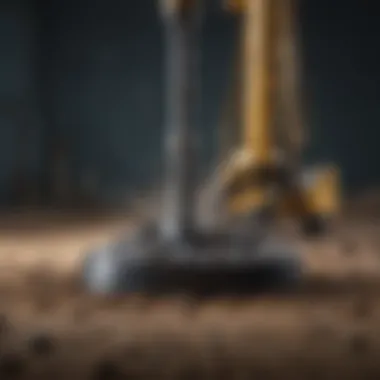Understanding Well Drilling Costs: Key Insights


Intro
The process of well drilling involves numerous complexities that can quickly confound both novices and experienced professionals alike. As industries increasingly rely on well water, understanding the intricate web of costs associated with new well drilling becomes imperative. This discourse aims to unravel those complexities, shedding light on how various elements—like geography, the type of drilling technologies employed, and even regulatory frameworks—intersect to determine overall expenditures.
Drilling a well is not just a matter of sinking a pipe into the ground and hoping for the best. It requires careful planning, substantial investment, and a keen awareness of environmental considerations. The costs involved can vary significantly from one locale to another, influenced by factors ranging from geological characteristics to labor markets. This analysis will highlight key concepts and terminology related to this subject, enabling readers to navigate the well drilling landscape with enhanced clarity and confidence.
Preface to Well Drilling
Understanding well drilling isn't just for the folks in hard hats or the engineers commanding heavy machinery. It plays a significant role in various aspects of our lives, from ensuring clean drinking water to providing the energy sources that keep our homes running. This aspect of well drilling isn't simply a technical exercise; it’s a vital process that intersects with environmental stewardship, economic development, and community health. The crux of the matter is knowing what goes behind the scenes—both in terms of technical execution and the costs associated with it.
Definition of Well Drilling
Well drilling refers to the method of creating a hole in the ground to access underground water, oil, gas, or geothermal resources. This process isn't merely about boring into the earth; it's a calculated endeavor that requires precise techniques, equipment, and labor. Each well is unique in its requirements, driven by geological formations and the type of resource targeted. Being aware of these nuances helps one appreciate the complexity and investment involved in well drilling.
Types of Wells
There are several types of wells, each designed to serve a specific purpose according to the needs of the users. Here’s a closer look at three prominent types:
Water Wells
Water wells are predominantly drilled for the extraction of groundwater, providing a crucial supply of clean water. They can be developed in various geological settings, significantly impacting the local community's health and economy. The key characteristic of water wells is that they offer a sustainable and accessible means to meet water demands, making them vitally important for agricultural, residential, and industrial needs.
A unique feature of water wells is their depth which can vary notably based on local aquifer conditions. One advantage of these wells is their relatively low operational costs compared to other types of wells, ensuring that many households have access to freshwater. However, there can be disadvantages, too—like water table depletion, especially in over-extracted areas.
Oil Wells
Oil wells play a significant role in energy supply and economic growth but involve higher stakes and complexities. The key characteristic of oil wells is their high potential profitability, as they tap into oil reserves hidden beneath the earth. This makes them a favorable choice for investors and companies looking for lucrative ventures.
The unique feature of oil wells lies in their extraction technology—often employing advanced methods such as hydraulic fracturing or horizontal drilling. While a significant advantage is their row of potential high yields, the disadvantages typically include environmental concerns and hefty development costs.
Geothermal Wells
Geothermal wells contribute specifically to tapping into the earth's natural heat, providing a renewable energy source that’s environmentally friendly. The key characteristic of geothermal wells is their part in the push toward sustainable energy solutions.
The unique feature here is their ability to produce consistent energy with a minimal carbon footprint. The main advantage is their efficiency and sustainability when compared to fossil fuels. However, geothermal wells can impose higher upfront costs and are dependent on specific geological conditions, limiting their feasibility in some regions.
In summation, understanding the different types of wells is essential. This knowledge helps in evaluating their implications for resources, costs, and sustainability, setting the foundation for deeper discussions on well drilling costs throughout this article.
Factors Influencing Well Drilling Costs
Understanding the elements that affect well drilling costs is crucial for anyone involved in this field. These factors can make or break a project, impacting everything from initial budgets to long-term viability. By dissecting this area, professionals can better prepare for what lies ahead, ultimately making smarter decisions. The implications of these costs reach far beyond just green-lighting a drill site; they influence the overall strategy, execution, and even sustainability of the project.
Geographical Considerations
Regional Differences
When it comes to drilling, geography is a significant player. Certain areas may have more favorable conditions that ease the drilling process, while others might present challenges that inflate costs. For instance, drilling in remote or difficult terrains—like the Rocky Mountains—can require specialized equipment and techniques, elevating the overall cost.
Key characteristics here include:
- Terrain Variability: Flat regions often permit easier access compared to hilly or mountainous areas.
- Climate Factors: Areas with harsh weather conditions may necessitate additional protective measures for equipment.
This regional peculiarity can be beneficial for planning, as it allows for targeted strategies tailored to specific environments—ultimately leading to cost savings in execution.
Access to Resources
Resource availability cannot be understated. The proximity to machinery, skilled labor, and essential materials drastically impacts drilling operations. For example, regions rich in local resources usually experience lower transportation costs, which might not be the case in isolated locations.
Key points about access to resources include:
- Logistical Efficiency: Easily accessible resources mean less time spent transporting materials.
- Cost-Effective Solutions: Local sourcing can cut costs in hiring external vendors and reduce transit times.
However, in some regions, resource scarcity can dampen operational efficiency. If essential components are difficult to source nearby, a project can quickly spiral into unforeseen expenses, emphasizing the importance of initial assessments in planning.
Site Selection and Preparation
Land Use Permits
Securing land use permits is not just a bureaucratic step—it's a critical element in the drilling process. Regulatory compliance regarding land usage can lead to significant costs and delays if not handled correctly. Without the right permits, companies may face fines or even project shutdowns, pushing budgets to breaking points.
Highlighting this, the core benefits of managing land use permits include:
- Regulatory Compliance: Being on the right side of the law solidifies long-term project feasibility.
- Future-Proofing: Proper permits can also ease the path for future projects in the same location.
However, navigating the legal landscape can be arduous. It often requires upfront investment in knowledge and possibly legal counsel, suggesting the need for thorough vetting in initial planning stages.
Environmental Impact Assessments
Conducting thorough environmental impact assessments (EIAs) is paramount in the well drilling landscape. Not only do these evaluations identify potential adverse effects on ecosystems, but they also help companies align with regulatory standards that govern environmental considerations. A well-executed EIA isn't just a checkbox but a strategic maneuver to gauge risks that may rile up public sentiment or confront governance bodies.
Key characteristics include:
- Proactive Risk Management: Spotting issues before they arise can save bucks in the long run.
- Stakeholder Engagement: A positive environmental track record can bolster community relations and even entice investments.
However, it’s a double-edged sword; extensive assessments can take time and increase upfront costs. But, when weighed against potential fines or damage to reputation, these assessments often turn out to be worthwhile investments.
In sum, the factors influencing well drilling costs are vast and intricate, intertwining regional characteristics, resource access, site constraints, and legal obligations. Each facet presents its own challenges and opportunities, painting a complex picture for stakeholders. Understanding these elements well fortifies strategies and underscores the necessity of thorough preparation.
"The early bird might get the worm, but the second mouse gets the cheese."
This old adage captures the essence of the well drilling process—timeliness, planning, and diligence can yield extraordinary results.


Labor and Equipment Costs
In the quest to find effective solutions for well drilling, understanding labor and equipment costs becomes crucial. These expenses not only absorb a significant portion of the drilling budget but also directly impact the efficiency and success of the project. Whether it’s skillful hands guiding the machinery or the machines themselves laying the groundwork, both aspects play a vital role in determining overall expenditures. By dissecting the components of labor and equipment costs, we can comprehend their influence on the cost structure of well drilling projects.
Personnel Expenses
Skilled Labor Requirements
When it comes to well drilling, having skilled labor is like having the right keys to open the doors of success. Skilled labor requirements encompass not just the number of workers, but the specific competencies they bring to the table. Operators trained in advanced drilling techniques are essential as they minimize risks and enhance productivity.
One pivotal characteristic of skilled labor is their problem-solving ability in real-time. Issues can crop up without warning, and an experienced hand is needed to tackle those head-on. This makes skilled labor a wise investment, as it can save time and lower the likelihood of costly errors. However, it is worth noting that attracting such talent often comes with higher payroll demands, which can burden the initial budget, a consideration worth pondering for any project manager.
Training and Certifications
Moving onto training and certifications, these are essentially the building blocks that elevate a workforce's capability. Ongoing training ensures that personnel are up-to-date with industry standards and safety protocols. This commitment to continual education is not just a feather in one’s cap — it’s something that fosters trustworthiness in operations.
In terms of key characteristics, training enhances the employees' understanding of the equipment, leading to lower accident rates. It’s a popular choice for many projects because it pays dividends when drilling begins, creating a safer work environment. However, the downside lies in the upfront time and cost required for certification programs, which may be a sticking point for budget-conscious decision-makers.
Equipment Investment
Drilling Rig Costs
Drilling rig costs serve as a cornerstone of the overall financial framework. These costs vary considerably based on equipment type and necessary capabilities, reflecting both initial investments and ongoing operational expenditures. Investing in the latest technology can often provide better results, making them an attractive choice for serious operators.
A unique feature of high-quality rigs is their adaptability to various terrains, which, while advantageous, can often lead to higher upfront costs. Therefore, it's essential for companies to weigh these costs against the potential benefits. Ultimately, choosing the right drilling rig not only influences immediate expenses but also determines the operational efficiency throughout the lifetime of a project.
Maintenance and Repairs
Next up, we have maintenance and repairs, which are frequently overlooked until something breaks down. These costs can substantially impact a project’s budget and can disrupt timelines. Without an effective maintenance strategy, equipment failure can lead to costly delays.
A key characteristic of maintenance systems is that they often involve regular inspections and servicing, ensuring that all equipment is running smoothly. Predictive maintenance strategies can extend the life of machinery, ultimately saving money in the long run. However, investing in a routine maintenance plan can require upfront costs, which might deter some firms. Nonetheless, proactive maintenance can shield a project from the burden of unforeseen downtime, making it a wise investment in the grand scheme of things.
"In the world of well drilling, it’s not just about the tools at hand, but the craftsmen behind them that make the difference."
The interplay of labor skills and equipment efficiencies shapes the landscape of well drilling costs, and understanding these elements can empower professionals to make more informed decisions. By thoughtfully budgeting for personnel and equipment, companies can work towards mitigating risks and enhancing their overall operational success.
Material Costs and Supply Chain Impacts
Material costs play a central role in determining the overall expenses of well drilling projects. Understanding these costs, along with their implications on supply chain logistics, is essential for professionals in the field. As various elements come into play, including cost fluctuations, availability of materials, and sourcing strategies, their impact on budget and timelines cannot be overlooked.
Key Materials Required
Drilling Fluids
Drilling fluids, often called mud, are a fundamental ingredient in the drilling process. They serve several critical functions, such as cooling the drill bit, preventing collapse of the borehole, and transporting cuttings to the surface. The specific composition of drilling fluids can vary—water-based, oil-based, or synthetic—each with its pros and cons.
One key characteristic of drilling fluids is their ability to exert hydrostatic pressure. This is crucial for managing pore pressure in formation rocks, which can prevent blowouts. As such, water-based fluids are a popular choice due to their environmental friendliness and cost-effectiveness.
However, special attention must be given to the choice of mud’s additives. For instance, certain additives enhance the fluid's viscosity, aiding in the transport of drill cuttings but can increase costs. Depending on the geological conditions, the unique feature of drilling fluids like barite can improve performance but also contribute significantly to the budget.
Advantages:
- Cost-effective for many types of wells
- Environmentally friendlier options available
Disadvantages:
- Special additives can inflate costs
- Incorrect selection may lead to operational problems
Casing and Cement
Casing and cement are crucial materials that ensure the longevity and safety of a well. Casing provides structural support to the borehole, while cement seals the annular space between the casing and the rock formation, preventing any migration of fluids. The durability of casing materials, often steel or composites, is a vital characteristic that dictates the overall integrity of the well over time.
Moreover, cementing jobs are often one of the more labor-intensive and costly aspects of drilling. The unique feature of advanced cement blends comes into play here. They can offer superior performance under various pressure and temperature conditions, albeit at a higher price. Hence, while investing in top-tier casing and cement may seem like a splurge initially, it can mitigate costly failures down the road.
Advantages:
- Ensures structural integrity
- Prevents contamination of aquifers
Disadvantages:
- High up-front investment
- Repairing casing failures can be prohibitively expensive
Effect of Supply Chain Disruptions
Supply chain efficiency is a pivotal factor that can significantly sway material costs. When disruptions occur, they ripple through the industry, affecting pricing and material availability, which influences the overall cost structure of well drilling projects.
Global Supply Trends
Global supply trends often reflect fluctuations in minerals markets, which directly affect the price of drilling materials. Recent patterns show that heightened demand in emerging markets can drive costs up. This economic interplay underscores how interconnected the materials market is.
For well drilling, keeping an eagle eye on these trends becomes crucial. Understanding how shifts, like trade tariffs or geopolitical tensions, can send ripples through supply lines helps in making timely adjustments to procurement strategies. The unique feature of diversifying suppliers can offer a buffer against sudden price hikes, although it demands maintaining relationships with various vendors.
Advantages:
- Access to a variety of materials
- Potential cost savings through diverse sourcing
Disadvantages:
- Requires extensive research and relationship management
- Risk of inconsistencies in material quality
Local Sourcing Challenges


Local sourcing offers an immediate advantage in reducing transport costs and lead time, but it comes with its own set of challenges. A critical aspect of local sourcing is the availability and quality of materials. Not every region has easy access to high-grade drilling fluids or casing materials.
Additionally, local regulations can impact the feasibility of sourcing materials nearby. Navigating this labyrinth of local laws requires significant expertise. Local sourcing’s unique feature is that while it can lower transportation costs and support community economies, it can limit options if local suppliers cannot meet evolving project demands.
Advantages:
- Often more sustainable with reduced transport emissions
- Can foster local economic development
Disadvantages:
- Limited options can force compromises on quality
- Local suppliers may struggle with high-demand projects
In summary, the nuanced world of material costs and supply chain dynamics demands a keen understanding. As you navigate these waters, consider how each material choice and supply channel plays into the broader landscape of drilling expenses. By doing so, stakeholders can better strategize around their operations and budgets.
Role of Technology in Drilling Operations
In the ever-evolving landscape of well drilling, technology plays a critical role. As the industry grows, so do the methods and tools used. From the type of drills employed to the data analytics applied during operations, technology is fundamental in enhancing efficiency and conservation of resources. Adopting the right technologies means drilling can be done faster and with higher precision, ultimately impacting the overall costs involved.
Drilling Techniques
Conventional vs. Advanced Methods
When it comes to drilling techniques, the distinction between conventional and advanced methods stands out. Conventional methods, like rotary drilling, have been around for decades and are widely used due to their reliability. These techniques typically utilize a rotating drill bit to create holes in the earth. The main characteristic here is their ability to drill effectively on a range of terrains, but they can sometimes fall short in efficiency when compared to advanced methods.
On the flip side, advanced drilling methods—such as horizontal drilling or directional drilling—have emerged to tackle specific challenges. One of the key benefits of these methods is their capability to reach deposits that are not accessible through conventional techniques. For example, horizontal drilling can limit surface disruption and enhance resource recovery from varied angles. Yet, while these techniques often offer better returns on investment, they also involve higher initial costs and require sophisticated technology, which can be a barrier for some companies.
Automation in Drilling
Automation in drilling is revolutionizing operational practices. This entails using technology to perform tasks with minimal human intervention. The spotlight shines on remote-controlled rigs and automated drilling systems that enhance safety and precision. One significant benefit of automation is the reduction in labor costs; it ensures operations can continue around the clock without the risk of human error affecting performance.
A distinguishing feature of automated systems is their ability to collect and analyze data in real-time, leading to quicker decision-making. However, it's important to recognize the challenges posed by automation. The initial investment can be hefty, not to mention the complexity involved in training personnel to manage these advanced systems effectively.
Impact of Innovations
Cost-Effective Solutions
Cost-effective solutions are vital in promoting sustainable practices within the well drilling sector. Innovations such as advanced material use and novel drilling fluids are at the forefront. They can reduce expenses while also improving drilling performance. For example, the introduction of lighter and more durable materials in drilling equipment can lead to lower transportation costs and enhanced operational productivity.
The primary characteristic of such solutions is their dual benefit of cost savings and environmental stewardship. They allow companies to drill more effectively while also adhering to increasingly strict environmental regulations. Yet, it might be worth noting that these solutions often require upfront investment in research and development.
Efficiency Improvements
Efficiency improvements are the backbone of modern drilling operations. By integrating technologies like predictive analytics and machine learning, companies can significantly enhance their drilling operations. These innovations allow for data-driven decisions that lead to better resource management and cost optimization.
The key feature of such advancements is their ability to predict potential issues before they arise. As a result, this proactive approach can minimize downtime and greatly reduce costs. Nevertheless, while these systems can provide substantial benefits, the reliance on technology means that companies must navigate potential issues like system failures or cybersecurity threats.
"The impact of technology in the drilling sector is multifaceted; it can lead to significant cost reduction but also demands careful implementation to mitigate associated risks."
In summary, the integration of technology in drilling operations underscores its importance for the future of the industry. Understanding the differences between conventional and advanced techniques, embracing automation, and harnessing innovative solutions can greatly influence both the efficacy and cost-effectiveness of well drilling.
Regulatory and Compliance Costs
In any well drilling project, the significance of regulatory and compliance costs cannot be overstated. These costs represent not just monetary expenditures, but also the frameworks that dictate how and where drilling can occur. Understanding this subject is crucial for stakeholders aiming to navigate the complex landscape of well drilling. Missteps in compliance can lead to substantial financial penalties and project delays, which impacts overall profitability.
Understanding Regulatory Frameworks
Local Regulations
Local regulations are foundational in shaping the operational landscape of drilling projects. They often set the stage for everything from zoning laws to permits that must be secured before any drilling begins. A key characteristic of local regulations is their variability; what is acceptable in one region might be a complete no-go in another.
For instance, in areas known for high groundwater tables, stringent measures may be in place to avoid contamination. These regulations serve as a beneficial framework by ensuring that projects are undertaken with due regard for public safety and environmental sustainability. While they may seem like an inconvenience at first, these regulations often save costs related to future environmental cleanup or community backlash.
A unique feature of local regulations is their evolving nature, often requiring continuous education and adaptation. This can be both an advantage and a disadvantage: while it promotes better practices, it can also lead to increased costs related to compliance, such as legal fees or the need for specialized consultants.
Environmental Compliance
Environmental compliance encompasses a wide array of regulations that mandate operators adhere to practices that protect natural resources. This aspect is integral not just from a legal standpoint, but also in fostering community goodwill and public trust. Elements such as waste management, emissions controls, and habitat protection fall within this category.
A key characteristic of environmental compliance is its focus on sustainability. Many stakeholders view it as not just a regulatory hurdle, but a platform for establishing best practices that can lead to enhanced efficiency and reduced costs in the long run.
The unique feature of environmental compliance rules is their often rigid enforcement mechanisms, which can sometimes catch unwary operators off guard. Non-compliance can lead to hefty fines, making it crucial for drilling companies to stay informed about specific requirements. This characteristic can be seen as a downside; however, adherence can lead to operational harmony and community support—two invaluable assets in long-term project success.
Potential Fines and Liabilities
Impact on Total Costs
The financial implications of potential fines and liabilities are a significant consideration in the context of well drilling. These costs can escalate quickly if a company fails to adhere to local or environmental regulations.
A key characteristic of these impacts is their unpredictability. Total costs can swell without warning if fines are imposed due to oversight or lack of compliance with prescribed regulations. This unpredictability contributes to a challenging budget landscape, making it imperative for operators to prioritize regulatory alignment from the outset.
The unique feature here is the ripple effect of fines on project viability. A fine can snowball, affecting supplier relations and operational timelines, ultimately cascading into significant financial burden. As such, companies often find that investing in compliance-related resources may yield better long-term financial health.
Case Studies
Case studies offer illuminating insights into the potential ramifications of overlooking regulatory and compliance costs in drilling projects. These studies can serve as cautionary tales, highlighting how non-compliance led to financial ruin or major setbacks for companies involved in drilling operations.
A key characteristic of these case studies is their real-world applicability; they provide invaluable learning opportunities for the industry. Organizations can draw conclusions about efficient practices and even anticipate potential pitfalls their own projects might face.
What case studies uniquely reveal is the varying cost-impact across different regions and regulatory environments. Some companies, for instance, faced tens of millions in fines, while others managed within the bounds of their initial project budgets, provided they planned adequately for compliance. This learning gives practitioners a roadmap—not just for avoiding traps but for allocating necessary resources to stay compliant without hindering their operational capabilities.
In summary, understanding regulatory and compliance costs is vital for effective planning in well drilling. Ignoring these aspects can not only elevate costs but also stall projects and tarnish reputations in the industry.


Cost Reduction Strategies
In today’s competitive environment, managing expenses while drilling new wells is paramount. Choosing effective cost reduction strategies can mean the difference between a project finishing under budget or facing financial pitfalls. By implementing a few essential practices, stakeholders can simplify their operational efficiencies and reduce overall expenditures.
Planning and Feasibility Studies
Comprehensive Assessments
Comprehensive assessments play a vital role in the planning phase of well drilling. They provide an in-depth analysis of site conditions, associated risks, and historical drilling data. This layer of scrutiny ensures that all angles are explored before expensive equipment and labor are put to work. One key characteristic of comprehensive assessments is their emphasis on data-driven insights. By utilizing up-to-date geological surveys and market trends, stakeholders can tailor their drilling approach to meet specific objectives efficiently.
However, the unique feature they bring to the table is their ability to identify potential challenges early in the process. With advance knowledge of complications, such as subsurface rock formations or water table levels, adjustments can be made before work begins, ultimately saving time and resources. The downside? Such assessments can initially seem costly, but they often save more than they expend once all variables are considered.
Budgeting Techniques
Budgeting techniques are essential in maintaining control over a project’s finances. Good budgeting aligns project costs with expected returns, painting a clearer financial picture. A key characteristic of effective budgeting is its specificity; it breaks down costs into labor, materials, equipment, and unforeseen contingencies. This approach enables driller operators to track expenses meticulously, making it easier to navigate deviations in costs.
Its unique feature lies in utilizing software for real-time monitoring, helping teams adapt to changes quickly. One advantage is the ability to visualize spending versus income sources, thus informing necessary adjustments as a project unfolds. On the flip side, over-reliance on budgeting software without skilled oversight can sometimes lead to misallocation of funds, highlighting the need for human discretion.
Collaboration and Outsourcing
Contracting vs. In-House Operations
When it comes to drilling operations, the choice between contracting out services or keeping them in-house is a significant consideration. Contracting allows companies to leverage specialized skills and equipment without the overheads of permanent staffing. The key trait of contracting is flexibility; businesses can scale operations up or down based on project demand without incurring long-term costs.
However, there can be drawbacks. Contractor consistency and quality aren’t always guaranteed. A unique feature to highlight is the potential for mismatched priorities between contractors and the contracting company, which can lead to inefficiencies in workflow and planning. Balancing these concerns is essential for successful well drilling.
Best Practices
In any drilling project, applying best practices proves crucial in achieving consistent results while minimizing expenses. Best practices encompass a broad range of strategies, from relying on established processes to continuous training of personnel. A defining characteristic is their foundation on evidence-based methods developed over time. By integrating tried and true methods, teams can avoid common pitfalls and streamline operations.
The unique feature of best practices is their adaptability; they can evolve with new technologies and methods. For example, engaging the latest software solutions or equipment can enhance efficiency dramatically. Nonetheless, the main challenge lies in ensuring that all team members are on board with these practices to avoid fragmentation in approach and execution.
By focusing on comprehensive assessments, budgeting techniques, and collaboration strategies, well drilling projects can effectively manage and reduce costs, ensuring financial health and sustainability in an evolving market.
Future Trends in Well Drilling Costs
Understanding future trends in well drilling costs is essential for industry stakeholders, whether they are new entrants or seasoned veterans. As the market evolves, several factors begin to shape the financial landscape of drilling operations. In particular, renewable energy's rise alongside groundbreaking technological innovations plays a crucial role in redefining cost benchmarks and operational efficiencies.
Influence of Renewable Energy
Hybrid Systems
Hybrid systems represent a significant leap forward in drilling technology. These systems, which combine traditional fuel sources with renewable energy, are gaining traction for a variety of reasons. First and foremost, they cater to the growing demand for sustainable practices within the industry. By reducing reliance on fossil fuels, companies can not only cut their operational costs but also enhance their public image.
One of the key characteristics of hybrid systems is their ability to significantly lower emissions, making them an environmentally friendly choice. This connection to sustainability can also boost a company's appeal among investors who are increasingly focusing on environmentally responsible projects.
However, there are some unique features to consider, like the initial investment required for integrating hybrid technology. This upfront cost may be a stumbling block for smaller companies, putting them at a disadvantage compared to larger enterprises that can better absorb these expenses.
Market Shift Analysis
Market shift analysis is increasingly recognized as a vital tool in forecasting shifts in well drilling costs. This process examines how changes in consumer preferences, regulatory requirements, and resource availability can impact pricing. By keeping a pulse on market dynamics, companies can make more informed decisions about where to allocate resources and how to stay competitive.
The key characteristic of market shift analysis lies in its predictive nature. It enables stakeholders to anticipate changes, allowing them to prepare accordingly. This strategic insight can lead to financial savings and unlock new opportunities for growth.
On the flip side, the unique feature of this analysis is its complex nature. Gathering the necessary data and interpreting it accurately requires specialized skills and resources that not all companies have. Failure to accurately analyze market shifts could result in misguided investments and unexpected costs, posing risks to overall profitability.
Technological Advancements
Emerging Technologies
Emerging technologies are fast becoming cornerstone elements in managing well drilling costs. Innovations like real-time monitoring systems and AI-driven analytics allow for more precise operations, thus reducing waste and increasing efficiency. These technologies enable companies to optimize drilling processes, minimizing downtime and reducing resource consumption.
The key characteristic of these technologies is their capacity for data collection and analysis. With the insights garnered from this data, companies can make informed operational decisions that directly influence their cost structure. This data-driven approach not only enhances efficiency but can lead to long-term sustainability in cost management.
Nevertheless, while the advantages are numerous, the unique feature of these emerging technologies is their steep learning curve. The initial phases of implementation may require substantial training and adaptation, which can be daunting for some organizations, especially smaller firms with limited resources.
Forecasting Future Costs
Forecasting future costs has become an indispensable practice in today's volatile market. This process involves analyzing historical data, current trends, and predictive models to estimate future expenses. Accurate forecasting is crucial for budgeting, decision making, and setting realistic financial expectations.
A key characteristic of forecasting is its reliance on comprehensive data inputs and robust modeling techniques. Utilizing advanced analytics, businesses can fine-tune their predictions and prepare for potential cost fluctuations. This proactive stance can provide a significant advantage in maintaining a competitive edge in the industry.
However, the unique feature of forecasting lies in its inherent unpredictability. Factors such as unforeseen regulatory changes, natural disasters, or abrupt economic shifts can dramatically alter the landscape, leading to discrepancies between predicted and actual costs. Companies need to remain agile and adaptable to navigate these uncertainties effectively.
"The future of well drilling will be shaped by the adaptability of the industry to embrace sustainable practices and cutting-edge technologies."
Closure
Understanding the intricate details of well drilling costs is paramount for a myriad of stakeholders, from investors to environmental regulators. In this article, we have explored various elements that shape these costs, offering a well-rounded perspective on this complex theme. The need to grasp how costs are influenced by factors ranging from labor and materials to technology is essential. Having this knowledge not only aids in budgeting but also in strategic planning for future projects.
Summary of Key Insights
A compilation of the main points discussed throughout the article highlights several key insights:
- Types of Wells: Each type of well, whether it be for water, oil, or geothermal energy, presents unique cost structures and operational requirements.
- Geographical Impacts: Costs can vary significantly by region. For instance, remote areas often incur higher transportation costs for equipment and personnel.
- Regulatory Considerations: Compliance with local and environmental regulations can add layers of expenses that must be accounted for in the budgeting process.
- Technological Role: Advances in drilling technology can lead to cost savings and improved efficiency, but the initial investment is also a factor to weigh carefully.
- Cost Reduction Strategies: Planning, collaboration, and understanding market trends are pivotal for reducing drilling costs effectively.
These insights should serve as a guide for readers, reaffirming that being informed about the numerous variables at play can empower better decisions in the field of well drilling.
Final Thoughts on Cost Management
Effective cost management is not merely about cutting expenses; it’s about making informed choices based on thorough analysis. Initiating projects without a clear understanding of associated costs can lead to pitfalls that may derail even the most promising ventures.
To maintain a handle on costs, stakeholders need to:
- Conduct thorough feasibility studies to accurately gauge potential expenses.
- Stay updated on market changes as these can affect waste, downtime, and other expenses.
- Embrace collaborative approaches, considering outsourcing where beneficial, to leverage expertise and reduce overheads.
"Success in managing well drilling costs lies in a delicate balance between vigilance and strategic investment."
In essence, a proactive attitude towards cost management can minimize risks and enhance the overall efficiency of well drilling projects. As the industry evolves, continuous learning and adaptation will be key to thriving in this challenging landscape.







